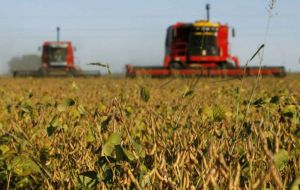MercoPress. South Atlantic News Agency
Corn replacing soybeans as the main crop for Argentine farmers
 The Rosario Trade Exchange estimates that Argentine farmers will be planting a record 7,4 million hectares of corn this year
The Rosario Trade Exchange estimates that Argentine farmers will be planting a record 7,4 million hectares of corn this year  The 2021/2022 corn harvest is expected at some 55 million tons and that of soybeans, 49 million tons
The 2021/2022 corn harvest is expected at some 55 million tons and that of soybeans, 49 million tons Argentine farmers are expected to sow more corn than ever this season, while soybeans will fall to an all time 15-year minimum because of the export policy of the current administration and the lack of the regulatory framework for genetically modified, GM, seeds.
This last season Argentine corn production surpassed Brazil, victim of a severe drought, and became the world's second exporter of corn, behind the United States. However regarding soybeans of which Argentina remains the main global supplier of soy flour, the planted area has been falling because of the slow promulgation process of the Seeds Law which implements the payment of royalties for the use of soy genetics, crucial for productivity and addressing ever more common droughts.
The Rosario Trade Exchange estimates that Argentine farmers will be planting a record 7,4 million hectares of corn this year, and 16,40 million hectares of soybeans, its lowest since 2006. The 2021/2022 corn harvest is expected at some 55 million tons and that of soybeans, 49 million tons.
“Corn has benefitted strongly from the new technology in the last ten years which allows to sow later in the season. Normally it was only September and hope for rain by Christmas. But now with the new technology half the corn can be planted in September and the other half in November”, pointed out the Rosario Exchange.
The Buenos Aires Cereals Stock Exchange estimates 7,1 million hectares of corn to be planted in the 2021/22 season.
“Late sowing enables corn yields to remain stable in dry years, while soy yields fall drastically”, according to Esteban Copati, a Buenos Aires cereal stock exchange analyst. A larger corn production from Argentina should help provide the world when supply is short and prices high. Earlier this month the US Department of Agriculture cut its production estimate by 2,7%.
Argentina's 2020/21 soy crop ended in June, reached 43,5 million tons, and corn, almost finished is expected to reach 48 million tons.
Argentina export tax policy help to understand the situation, on soybeans is 33% and 31% for soy flour and soy oil, while 12% for corn. Fiscal pressure on soy exports is too high and there is also the absence of a reasonable seeds law to take advantage of technology, it was pointed out at the Buenos Aires Cereal Exchange.
“Thus corn is taking the initiative, with lower taxes and the best technology”.




Top Comments
Disclaimer & comment rulesCommenting for this story is now closed.
If you have a Facebook account, become a fan and comment on our Facebook Page!